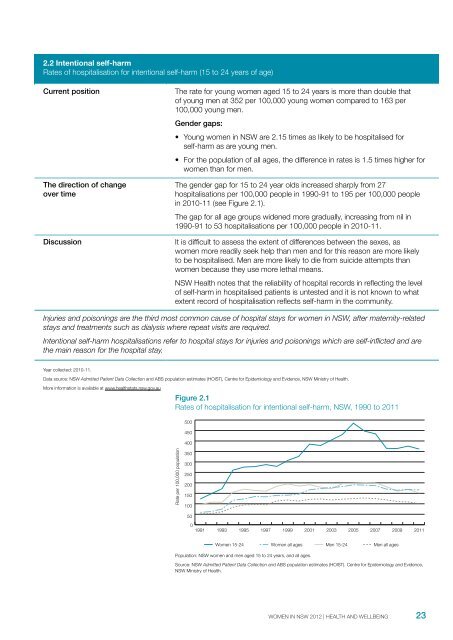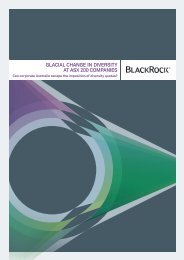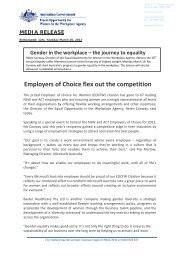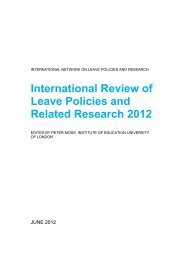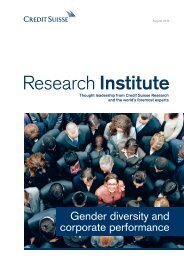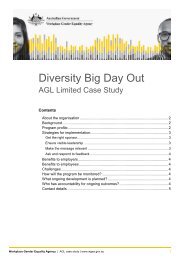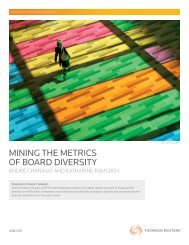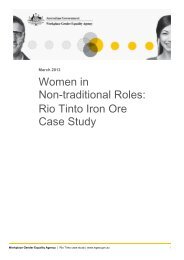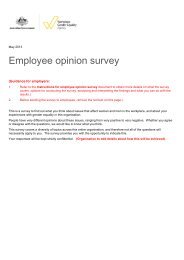Women in NSW 2012 - The Workplace Gender Equality Agency
Women in NSW 2012 - The Workplace Gender Equality Agency
Women in NSW 2012 - The Workplace Gender Equality Agency
You also want an ePaper? Increase the reach of your titles
YUMPU automatically turns print PDFs into web optimized ePapers that Google loves.
2.2 Intentional self-harmRates of hospitalisation for <strong>in</strong>tentional self-harm (15 to 24 years of age)Current position<strong>The</strong> direction of changeover timeDiscussion<strong>The</strong> rate for young women aged 15 to 24 years is more than double thatof young men at 352 per 100,000 young women compared to 163 per100,000 young men.<strong>Gender</strong> gaps:• Young women <strong>in</strong> <strong>NSW</strong> are 2.15 times as likely to be hospitalised forself-harm as are young men.• For the population of all ages, the difference <strong>in</strong> rates is 1.5 times higher forwomen than for men.<strong>The</strong> gender gap for 15 to 24 year olds <strong>in</strong>creased sharply from 27hospitalisations per 100,000 people <strong>in</strong> 1990-91 to 195 per 100,000 people<strong>in</strong> 2010-11 (see Figure 2.1).<strong>The</strong> gap for all age groups widened more gradually, <strong>in</strong>creas<strong>in</strong>g from nil <strong>in</strong>1990-91 to 53 hospitalisations per 100,000 people <strong>in</strong> 2010-11.It is difficult to assess the extent of differences between the sexes, aswomen more readily seek help than men and for this reason are more likelyto be hospitalised. Men are more likely to die from suicide attempts thanwomen because they use more lethal means.<strong>NSW</strong> Health notes that the reliability of hospital records <strong>in</strong> reflect<strong>in</strong>g the levelof self-harm <strong>in</strong> hospitalised patients is untested and it is not known to whatextent record of hospitalisation reflects self-harm <strong>in</strong> the community.Injuries and poison<strong>in</strong>gs are the third most common cause of hospital stays for women <strong>in</strong> <strong>NSW</strong>, after maternity-relatedstays and treatments such as dialysis where repeat visits are required.Intentional self-harm hospitalisations refer to hospital stays for <strong>in</strong>juries and poison<strong>in</strong>gs which are self-<strong>in</strong>flicted and arethe ma<strong>in</strong> reason for the hospital stay.Year collected: 2010-11.Data source: <strong>NSW</strong> Admitted Patient Data Collection and ABS population estimates (HOIST), Centre for Epidemiology and Evidence, <strong>NSW</strong> M<strong>in</strong>istry of Health.More <strong>in</strong>formation is available at www.healthstats.nsw.gov.auFigure 2.1Rates of hospitalisation for <strong>in</strong>tentional self-harm, <strong>NSW</strong>, 1990 to 2011500450400Rate per 100,000 population35030025020015010050019911993199519971999200120032005200720092011<strong>Women</strong> 15-24 <strong>Women</strong> all ages Men 15-24 Men all agesPopulation: <strong>NSW</strong> women and men aged 15 to 24 years, and all ages.Source: <strong>NSW</strong> Admitted Patient Data Collection and ABS population estimates (HOIST). Centre for Epidemiology and Evidence,<strong>NSW</strong> M<strong>in</strong>istry of Health.WOMEN IN <strong>NSW</strong> <strong>2012</strong> | HEALTH AND WELLBEING23


